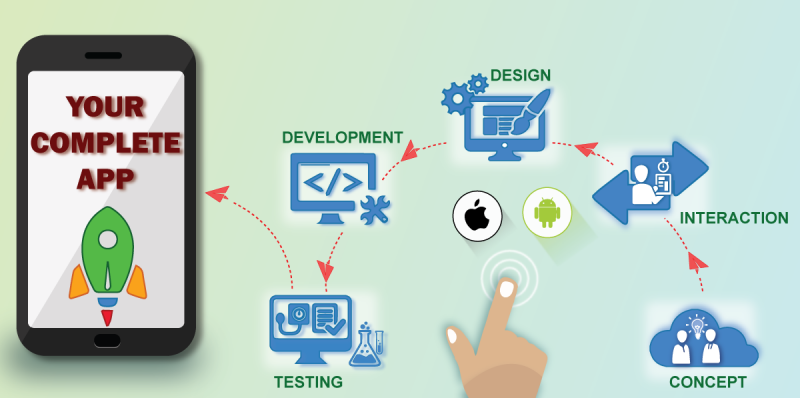Mobile apps have become an integral part of our daily living. These days we use apps to books rides (uber), we shop with apps (konga, jumia), we use apps to circumnavigate a city or province (Google maps). Even organisations use apps as a channel of customer communication for brands and a source of profit. With over 200 billion downloads annually, they are not just tools, they have become essential to our daily living.
What does it really take to develop an app? Let's go through the process together:
1. Idea and Research.
It always starts with an idea. What may be seen as an excellent idea might have been done years ago and failed miserably, which is why research is of the essence. Research will help you Identify a problem or problems the app is going to solve. A Lot of work goes into it. You have to be clear on what the problems are and how this app is going to be a perfect fit for solving this problem(s).
2. Identification Phase.
This basically entails identifying:
i. Target users of the apps.
This is an extension of the research stage where you should have a clear vision regarding the target group for your app. An app should always be developed keeping in mind the target users of the application. It enhances the success ratio of the app
ii. Revenue model.
The growth rate of the app market is massive, revenue generation is a major success indicator of any app, it should be one of your major priorities while developing an app. Your app revenue model should include:
This is the most common revenue model seen in apps. Apps developed for this model are usually free for user, it redirects us to advertisers for revenue generation. The aim is to gather a sizeable user base and accumulate enough user user data. Collected data is then sorted for relevant information and sold to app publishers, who in turn pay to place targeted ads in the app.
This is the most common revenue model seen in apps. Apps developed for this model are usually free for user, it redirects us to advertisers for revenue generation. The aim is to gather a sizeable user base and accumulate enough user user data. Collected data is then sorted for relevant information and sold to app publishers, who in turn pay to place targeted ads in the app.
In this model users are made to pay at the point of downloading the app, similar to how products are paid for in shops and supermarkets. In this model, revenue is made concurrently with the downloads. To boost up the number of downloads your app must have perceived value for the money paid, accompanied by a fantastic app listing which include screenshots, five-star reviews, which makes it stand out from similar free apps.
As the name implies, purchase transactions can be carried out through the app. Just like the e-commerce platforms, this model makes your app a sales channel where users can buy virtual and physical items.
This model is basically a pay later of free trial. Users can sign up and have access to other services. This is model is best for service providing apps.
These model is the most recent in the world of app revenue generation. Advertisers provide users with gifts once they surpass a particular threshold in the app. Advertising can be incorporated into the app while ensuring users are happy, as they are rewarded for carrying out certain actions in the app.
iii. App framework to be used for developing the app.
According to Techopedia an app framework acts as the skeletal support to build an application. The intention of designing application frameworks is to lessen the general issues faced during the development of applications. This is achieved through the use of code that can be shared across different modules of an application. Application frameworks are used not only in the graphical user interface (GUI) development, but also in other areas like web-based applications. Frameworks are theimportant driving tools for building any mobile or web application. It must be remembered that every project or app has a different requirement and so the choice of the framework must be made carefully and after ascertaining the other essential factors.
3. Designing your app.
This is yet another significant factor for a successful app. The developers call it UI design – (User interface). These days developers concentrate so much on the UI because it is a crucial factor to the success of an app. An app cannot be considered great if it has a terrible user interface. Many apps have failed because of their inability to design a user friendly interface. Designing an app is becoming increasingly popular as it creates an instant impact on the mind of the user while ensuring usability of an app.
4. Select approach to develop the app: Native, web or Hybrid.
This phase is absolutely important. It is usually determined by the time and budget constraints of the client.
Native: A native application is a software program that is developed for use on a particular platform or device. Because a native app is built for use on a particular device and its OS, it has the ability to use device-specific hardware and software. Native apps can provide optimized performance and take advantage of the latest technology, such as a GPS, compared to web apps or mobile cloud apps developed to be generic across multiple systems.
Web: A web application is a computer program that utilizes web browsers and web technology to perform tasks over the Internet.
Hybrid apps: A hybrid application (hybrid app) is one that combines elements of both native and Web applications. Native applications are developed for a specific platform and installed on a computing device. Web applications are generalized for multiple platforms and not installed locally but made available over the Internet through a browser. Hybrid apps are often mentioned in the context of mobile computing.
5. Build a prototype.
This the stage where you can develop a facsimile of the actual app you intend to develop. Prototypes are not functional, but they can help you see the areas in the app that need adjustments, functions that are relevant or irrelevant etc. Actually a prototype makes it quite easier to sell your idea to potential buyers who can now actually view the tangible benefits instead of just visualizing or reading product descriptions.
6. Select and integrate the best analytical tool for the app.
This is where you identify tools that you can use to capture all the relevant metrics of the app, i.e. – Number of downloads, Number of users, Number of reviews, etc.
7. Select Beta Testers - get their feedback and integrate relevant ones
-
(According to Bugfender) Beta testing is one of the most important and critical phases of the software development lifecycle. Beta testing serves several purposes, it leads to one thing which is – it improves customer experience. Users are now way smarter than ever due to their experiences with different apps and they know the options they have; if you fail to deliver a good user experience through your mobile apps, they would move on to other apps and would never come back.
8. Deploy the app
Deploying an app needs a lot of planning and control of the movement of releases to test and live environments. The major aim of Deployment is to ensure the integrity of the live environment is protected and that the correct components are released.
9. Metrics Capturing
The number of Mobile app users have grown tremendously in the last 5 years, because of this, accurate metrics are super important. As the number of users grows, the need to collect metrics become more important.
10. Update your app with improvement and fresh features
After capturing all the metrics needed, it is imperative that you update your app with new features and improvements. An app without these improvements and fresh innovative features loses its usability in the long term. Ensure you keep updating your app to meet new guidelines offered by the various platforms, don’t let your apps remain stagnant.
We can see, that building an app is a long and complex process that requires lots of preparation, patience, and dedication to execute properly. However, it is important to understand the process first before diving into it.


















